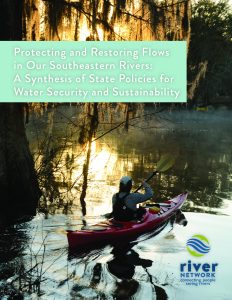Protecting and Restoring Flows in Our Southeastern Rivers – Report Release

Lost Cove Creek, Katherine Baer
A clear memory of growing up in Atlanta is the summer thunderstorms that broke the humidity and made for fun playing and splashing around in the warm air and our backyard creek. The southeast has long been a place of abundant rainfall with some mountain areas receiving over 80 inches a year. Approximately two-thirds of the population gets it drinking water from surface water and the region is home to unparalleled aquatic biodiversity – our Southeastern rivers are also places of grand beauty, world-class fisheries, and outstanding canoeing and kayaking.
But the Southeast is increasingly water stressed, placing our rivers and communities at-risk. Consider that water yields from southeastern forests have been declining since the 1970s and populations continue to sprawl and grow, placing more demands on water resources. Construction and operation of dams and reservoirs, water withdrawals, water transfers, wasteful water use, wastewater discharges, and increased development has adversely affected Southeastern rivers, with rivers in some places running dry. Climate change creates further pressure and uncertainty surrounding water security and sustainability. Western North Carolina dipped into drought this summer, South Carolina is bracing for further drought and the water allocation dispute between Georgia, Alabama and Florida heads to the Supreme Court on Halloween (scary!).
The good news is that th ere are steps we can take, through policies and practices for more sustainable water management, to reduce and mitigate this stress and lead to healthy flows for people and nature. Toward this goal, River Network is releasing our report Protecting and Restoring Flows in Our Southeastern Rivers – A Synthesis of State Policies for Water Security and Sustainability that provides an evaluation of the important role of and opportunity for state-based policies to tackle these issues.
ere are steps we can take, through policies and practices for more sustainable water management, to reduce and mitigate this stress and lead to healthy flows for people and nature. Toward this goal, River Network is releasing our report Protecting and Restoring Flows in Our Southeastern Rivers – A Synthesis of State Policies for Water Security and Sustainability that provides an evaluation of the important role of and opportunity for state-based policies to tackle these issues.
When deciding which policies to evaluate, given that there are a range of threats to river flows in the region, we correspondingly selected a range of policies, starting with the scientific foundations of water budgets and moving to supply management and flow protection and then demand management and finally the management of the built environment. While evaluated separately, these policies are overlapping and should ideally be considered in an integrated manner.
What we found is that while overall, there is much room for improvement of these Southeastern state policies, there are also a number of bright spots and opportunities to build on strong foundations. Georgia, for instance, has one of the strongest policies for reducing water loss, a key policy for reducing water demand, in the country. Tennessee makes strong use of Clean Water Act permitting to maintain healthy flows and South Carolina recently required surface water withdrawal permitting for the first time. All of these advances have been influenced by work of the watershed community in shaping policy and watchdogging implementation.
Fortunately, the southeast is home to many community and watershed groups dedicated to improving their local waterways and using a variety of approaches to protect and restore their rivers. We hope that by evaluating a series of state policies, this report provides resources, highlights and models, and next steps communities can take to learn more as they chart policy priorities.
Regular thunderstorms may not mark my daughter’s afternoons, but with the continued dedication of many, she will have rivers to paddle and ample clean water to drink.




